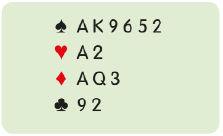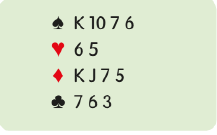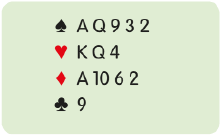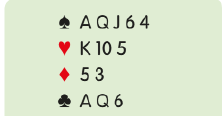Source: Mr Bridge
One of the most important things to do in a constructive auction is to limit your hand. What does this mean exactly? Usually limiting your hand means telling partner how many points you have; occasionally it means telling partner what level you have aspirations to (i.e. whether you are interested in a part-score only, or game or perhaps even slam). Limit bids are usually raises of partner’s suit or no-trump bids. Limit bids thus help partner to judge not just how high to go but what denomination in which to play. Change of suit bids and forcing bids are the opposite – they are usually unlimited bids. Let us start with a common situation:
 You hold the hand above and open 1NT (12-14). Partner responds 3
You hold the hand above and open 1NT (12-14). Partner responds 3![]() showing slam interest with at least six spades. What would you bid? Right, you should bid 4
showing slam interest with at least six spades. What would you bid? Right, you should bid 4![]() as a cue bid. You have only 13 points but you have limited the strength of your hand by opening 1NT so partner will expect at most 14. You have also limited the shape of your hand, which is why partner knows that 4
as a cue bid. You have only 13 points but you have limited the strength of your hand by opening 1NT so partner will expect at most 14. You have also limited the shape of your hand, which is why partner knows that 4![]() shows the ace of clubs and agrees spades; with a long string of clubs, you would have opened something else. You have nothing to be ashamed of – you have three trumps, a possible ruffing value with your doubleton diamond and a couple of useful control cards. See how opening 1NT made the subsequent bidding easier; you do not have to feel worried that partner will expect more. For the record partner held…
shows the ace of clubs and agrees spades; with a long string of clubs, you would have opened something else. You have nothing to be ashamed of – you have three trumps, a possible ruffing value with your doubleton diamond and a couple of useful control cards. See how opening 1NT made the subsequent bidding easier; you do not have to feel worried that partner will expect more. For the record partner held…

and gratefully used Blackwood to reach the cold slam. Another common situation: You pick up…

Partner opens 1![]() and you raise to 2
and you raise to 2![]() . Next partner makes a game try of 3
. Next partner makes a game try of 3![]() -what now? Well your 2
-what now? Well your 2![]() limited your hand. It showed 6-9 points with spade support. In that context, you are above minimum with help in diamonds so you have an easy 4
limited your hand. It showed 6-9 points with spade support. In that context, you are above minimum with help in diamonds so you have an easy 4![]() bid. Partner will not be disappointed with your dummy; he knows you hold at most 9 points. Partner’s hand:
bid. Partner will not be disappointed with your dummy; he knows you hold at most 9 points. Partner’s hand:

4![]() should make in comfort. Whenever partner makes a limit bid – a no-trump bid, a raise or preference to your suit or perhaps a non-forcing repeat of his suit – stop to work out the combined values. You are probably doing this without realising it already. For instance, if partner opens a 12-14 1NT, you know that with 14 points you can go for game but not a slam.
should make in comfort. Whenever partner makes a limit bid – a no-trump bid, a raise or preference to your suit or perhaps a non-forcing repeat of his suit – stop to work out the combined values. You are probably doing this without realising it already. For instance, if partner opens a 12-14 1NT, you know that with 14 points you can go for game but not a slam.
Now you may be ready for a more subtle situation, one that came up in a match.

You hold the above hand as South playing imps (teams). Partner opens 1![]() and the auction continues:
and the auction continues:

Your 2![]() was a natural jump shift, forcing to game. Partner’s 3
was a natural jump shift, forcing to game. Partner’s 3![]() rebid suggests a six-card or possibly strong five-card suit. Since 3
rebid suggests a six-card or possibly strong five-card suit. Since 3![]() is forcing it does not show a minimum opening, though often partner will have one. Neither player has thus made a limit bid so far. Here I think the correct bid is clear. Bid 3NT. This limits your hand to some extent. You have shown some interest above 3NT already (by making the strength-showing jump shift). The time has come to suggest that you have ‘limited’ interest past game (because 3NT is not forcing) not to mention that you have the other suits adequately stopped. This sequence should show 16-18 points and stoppers in the unbid suits. If partner chooses to look for slam, he will now not be disappointed with your hand.
is forcing it does not show a minimum opening, though often partner will have one. Neither player has thus made a limit bid so far. Here I think the correct bid is clear. Bid 3NT. This limits your hand to some extent. You have shown some interest above 3NT already (by making the strength-showing jump shift). The time has come to suggest that you have ‘limited’ interest past game (because 3NT is not forcing) not to mention that you have the other suits adequately stopped. This sequence should show 16-18 points and stoppers in the unbid suits. If partner chooses to look for slam, he will now not be disappointed with your hand.
Summary
See how easy the bidding was on these three deals. My advice? Limit your hand!
